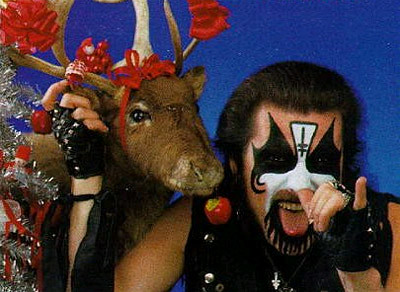
King Diamond: No Presents for Christmas
I’m making a post on Christmas day, which if nothing else should indicate the degree of reverence I have for the holiday season.
Christmas, and the train-wreck of bad taste that ensues, is not entirely without its benefits, particularly the unquestionably awful effect it has on rock music. Artists struggling to maintain their hair-flicking, could-give-a-fuck bad-assery through a three-and-a-half minute ditty about magic always makes for priceless entertainment. So without further ado….To the YouTube!
Posted by Mildred Von on December 25th, 2007
Filed under \m/, Music, Silly-looking types | Comments (10)

This Yakut winter spirit is akin to the Russian Grandfather Frost [more on him later]. Bull of Frost resides in the coldest part of Siberia and is a representation of the Mammoth according to Yakutian shaman traditions. His robes are adorned with traditional tribal patterns and beads in addition to seasonal snowflakes.
In ancient Yakut folklore, malady the Mammoth is a subterranean creature that breaks thick winter ice with his horns, and these horns are represented in this costume as part of the headdress. Because of their presumed underground dealings Mammoths were also associated with the world of the dead, the realm in which shamans ruled. Shamans communed with Mammoth spirits in rituals and immortalized them in art and amulets which are found in Siberia and Russia even in present day.
Posted by Zoetica Ebb on December 25th, 2007
Filed under Fairy Tales, Russia, Ye Olde | Comments (8)
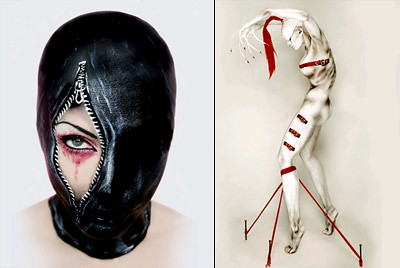
Making still images with bodypaint is becoming a bit of a lost art in the age of Photoshop. Why sit there and paint on someone for 13 hours, a nightmare of smudges and sore muscles, when you can just copy, paste and apply a mask? Body painter Nelly Recchia would explain that it’s the same as digital video vs. film; each is a legitimate medium, but that sometimes the “old way” of doing something can bring out a certain depth that you just can’t achieve with easy new techniques.
To Recchia, body painting is a ritualistic act, dating to the prehistoric age, which communicates our desire to transform ourselves and transcend the human body. She does use Photoshop occasionally, but only for minor corrections; the bulk of the work has to be done with models posing the same way for hours, a task that requires patience and strength. In the end, the models in her work glow with a type of poised discipline that Photoshop could never give.
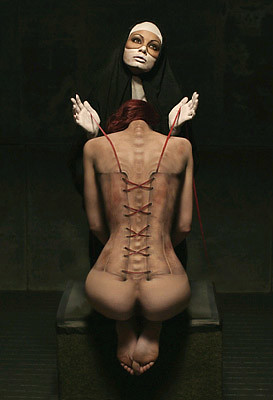
Posted by Nadya Lev on December 24th, 2007
Filed under Art, Fetish, Photography | Comments (3)
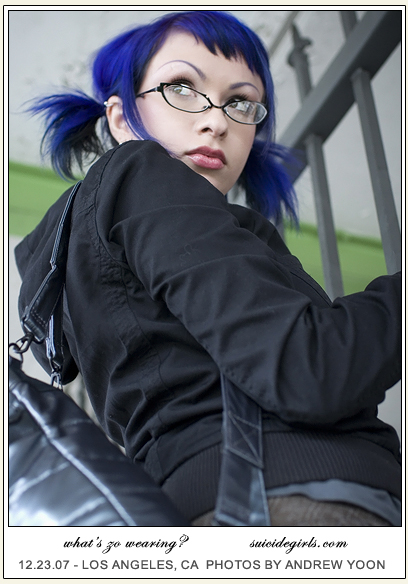
Just a little longer until the mass hysteria subsides and we can resume our lives. While I do not personally condone babies or Jesus and am thus left cold to the concept of Christmas, I adore New Year’s Eve. Turning of the tides, a symbolic clean slate – the lot of it, I dig. Presents and snow are pretty great as well. I even like seeing sparkling decorated houses but what I do take issue with [besides the ever-present music] is people wearing Santa hats. Just, you know, out. Shopping, driving, what have you. What does it mean?
Yesterday while traversing the already-dangerous terrain of a mall I saw a woman, ahead of me in line, wearing an oddly filthy and balding Santa hat. To her credit she was carrying a coordinating red purse. That unfortunate hat, however, made me think for a moment this was a misguided vagrant robbing the place. Why did she do it? I imagine it as a signal of despair, an S.O.S. flag breaking out of the sea of Christmas psychosis. Or is it a beacon of acceptance? Whatever reason you might have, from a stylistic standpoint I strongly suggest saving the hat until you get to the party if you really must wear one.
Posted by Zoetica Ebb on December 23rd, 2007
Filed under Fashion, Madness, What's Zo Wearing? | Comments (4)
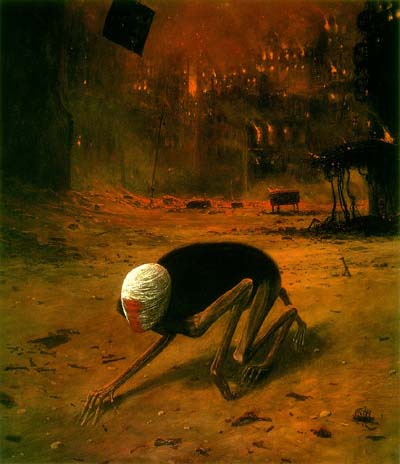
Artist Zdzislaw Beksiński is best known for his immense, obsessively detailed paintings of catastrophic landscapes, surreal humanoid figures and afflicted nudes. Born in 1929, he grew up in southern Poland, then traveled to Krakow to study architecture where he subsequently spent several miserable years working as a construction site supervisor. His work from that era is primarily photography and sculpture.
In his mid thirties, Beksiński shifted his focus to painting large, purely abstract pieces on wooden boards (he preferred wood to canvas). Eventually, their form and structure became more straightforward and he entered a self-proclaimed “fantastic period” reminiscent of Bruegel, Ernst or Bosch, and drawing comparisons to his Swiss contemporary, H.R. Giger.
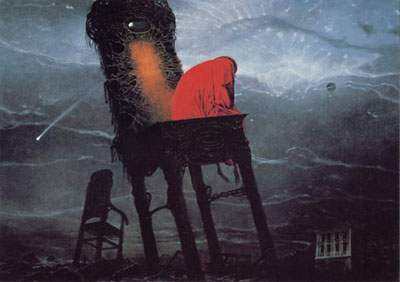
Beksiński’s post-apocalyptic vision, much like Giger’s, is uniquely disturbing owing in part to a highly developed architectural eye. His manipulation of scale and manic overworking of texture is ingenious. Overwhelmingly huge structures rise up from dust or empty desert. Sinewy figures cavort under ominous skies.
Posted by Meredith Yayanos on December 22nd, 2007
Filed under Architecture, Art, End of the World, Horror, Sci-fi, Surreal, Uber | Comments (60)
To cleanse your palate of the awful goth fashion I inflicted on you yesterday, here are pictures of some hawt men wearing fashions from centuries past, mainly Victorian.
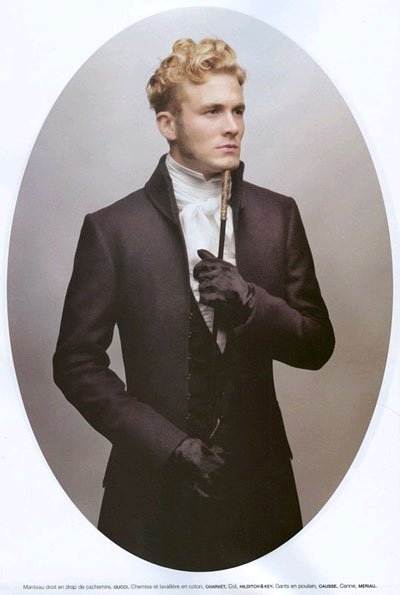
You can see the rest of the images here, courtesy of my friend Kat. Not sure which fashion magazine these came from, but YEAH!
Gloves + cane + covered neck = I’d hit it like the angry fist of god.
Posted by Nadya Lev on December 22nd, 2007
Filed under Fashion, Stroke Material, Ye Olde | Comments (5)
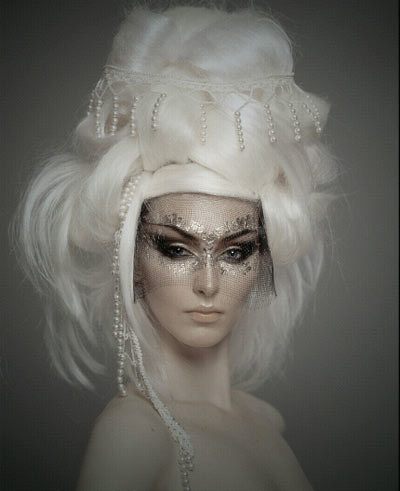
I love this photo by Hyperion for its milky, opalescent quality. Most “scene portraits” try to be loud and in-your-face, so it’s interesting to see portraits that are so muted that still manage to resonate a great deal of strength. Hyperion shoots mostly on film and uses sculptural hairpieces to fill up the square compositions. I sometimes disagree with the makeup choices in his images, but when it all comes together, it’s pure magic.
Posted by Nadya Lev on December 21st, 2007
Filed under Art, Goth, Hair, Photography | Comments (3)

Today we are going to play a game! It’s called “Gothic Outfit or Halloween Costume?” There are eight gothic ensembles in this post; some of them are actual outfits designed by alternative clothing labels to be worn out and about in the scene, others are Halloween costumes intended for adults who want to play-pretend to be goths one day out of the year. Can you guess which is which? Test yourself after the jump!
Posted by Nadya Lev on December 21st, 2007
Filed under Goth, Silly-looking types, Why | Comments (30)
Dee is an unknown superstar, casting songs like blessings… She is one of the most remarkable and unclassifiable artists I have ever encountered. Muse, manic, maniac, possessed by such beauty and pain, so intensely real and yet so mythical. Songster, trickster, breaker of hearts, with songs so cruel and kind that it leaves me spinning.
–David Tibet of Current 93
A gusty spring evening in Manhattan in the late 90s. It’s sort of dead in the East Village, not a lot of people out. I’m sitting at some sidewalk cafe nursing a hangover when I hear the distant wheeze of an accordion and this implacable, warbling voice. At first I figure it’s music on the cafe stereo so I don’t look up, but I’m thinking… who on earth does that vocalist remind me of? Mel Torme? Biff Rose? My great auntie? Such an oddly comforting sound. Gradually it dawns on me that the music is actually coming from up the street and getting louder. I finally look up from my cappuccino to see this wild-haired, cat-faced lady gliding up to the curb, perched 12 feet in the air on a custom-built tricycle with an enormous gilded harp lashed to the back.
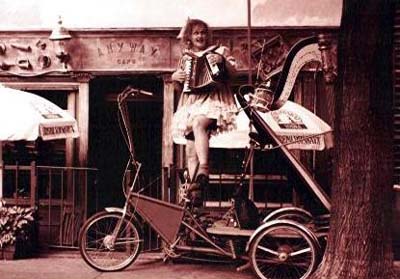
She parks her trike next to a Harley Davidson, carefully dismounts with her accordion and croons a sad, sweetly funny song about a sailor… or a girl… a small crowd gathers, beaming her beatific smile back at her. At the end of her ditty she graciously curtsies, accepting coins and small bills from all of us, then gets back on her tricycle and pedals away, cackling insanely. She is an irresistible creature. The cheers and applause continue long after her waving form has disappeared around the corner.
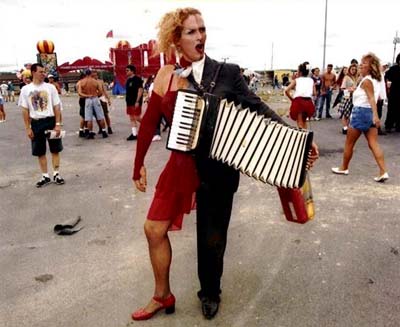
Fast forward a couple of years. A band called Antony and the Johnsons is taking the city by storm, and I recognize the harpist by her contagious cackle. Her name is Baby Dee, and apparently she’s made it her life’s calling to charm the pantaloons off everyone she meets, including Will Oldham, Michael Gira, Marc Almond and David Tibet, the last of whom started releasing Dee’s solo albums on his record label Durtro a few years ago.
Posted by Meredith Yayanos on December 20th, 2007
Filed under Cirque, Fairy Tales, Gender, Music, Queer | Comments (13)
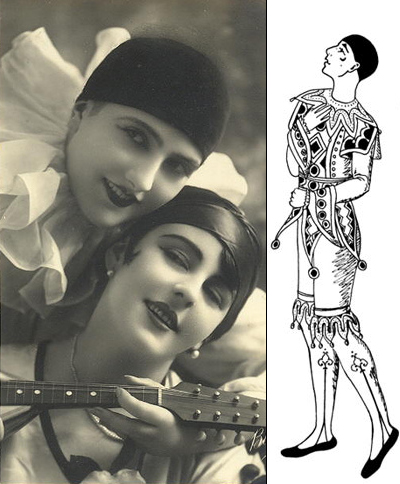
Pierrot was my first crush, and I mean the very first one, the one before real life boys, girls, etc. It all began with a life size doll [the size of a 6 year old anyhow] of a crying jester. More of a fusion of Pierrot and Harlequin, he had long noodly limbs, painted fingernails and a white made up moon-face with permanent blue teardrops slightly raised on the plastic surface. I assigned him a variety of appropriately tragic personalities in accordance with whatever game I was playing that day.
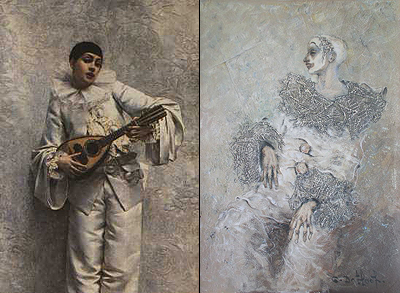
The name “Pierrot” didn’t hold any meaning until I read Buratino – Tolstoy’s version of Pinnochio. He was Buratino’s dismal friend, eternally pining for Malvina the blue-haired doll. I was smitten by his dapper costume in the 1975 film version of the book. The magnificent ruff and floor-length sleeves on the squeaky pallid boy left a permanent impression.
Posted by Zoetica Ebb on December 19th, 2007
Filed under Art, Fairy Tales, Goth, Silly-looking types | Comments (12)
















